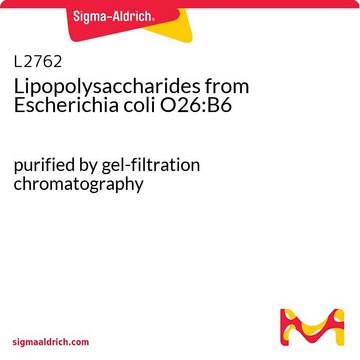L2143
Lipopolysaccharides from Escherichia coli K-235
purified by phenol extraction
Sinonimo/i:
LPS
About This Item
Prodotti consigliati
Origine biologica
Escherichia coli (K-235)
Livello qualitativo
Stato
lyophilized powder
Purificato mediante
phenol extraction
Impurezze
<3% Protein (Lowry)
Colore
white to faint yellow
Solubilità
water: soluble
Condizioni di spedizione
ambient
Temperatura di conservazione
2-8°C
Cerchi prodotti simili? Visita Guida al confronto tra prodotti
Descrizione generale
Applicazioni
- Establishment of disseminated intravascular coagulation (DIC) model by a single iv administration of Escherichia coli-derived lipopolysaccharide (LPS) to cynomolgus monkeys and evaluation of its pathophysiological status.: This study established a DIC model in cynomolgus monkeys using E. coli-derived LPS, providing insights into the pathophysiological status and potential therapeutic interventions for DIC (Minomo et al., 2017).
- Different bacterial lipopolysaccharides as toxicants and stressors in the shrimp Palaemon elegans.: This research explored the toxic effects of various bacterial LPS, including E. coli K-235, on the shrimp Palaemon elegans, advancing the understanding of LPS-induced stress responses in marine organisms (Lorenzon et al., 2002).
Azioni biochim/fisiol
Nota sulla preparazione
Altre note
Prodotti correlati
Avvertenze
Danger
Indicazioni di pericolo
Consigli di prudenza
Classi di pericolo
Acute Tox. 2 Oral
Codice della classe di stoccaggio
6.1A - Combustible acute toxic Cat. 1 and 2 / very toxic hazardous materials
Classe di pericolosità dell'acqua (WGK)
WGK 3
Punto d’infiammabilità (°F)
Not applicable
Punto d’infiammabilità (°C)
Not applicable
Dispositivi di protezione individuale
Eyeshields, Gloves, type N95 (US)
Scegli una delle versioni più recenti:
Certificati d'analisi (COA)
Non trovi la versione di tuo interesse?
Se hai bisogno di una versione specifica, puoi cercare il certificato tramite il numero di lotto.
Possiedi già questo prodotto?
I documenti relativi ai prodotti acquistati recentemente sono disponibili nell’Archivio dei documenti.
I clienti hanno visto anche
Il team dei nostri ricercatori vanta grande esperienza in tutte le aree della ricerca quali Life Science, scienza dei materiali, sintesi chimica, cromatografia, discipline analitiche, ecc..
Contatta l'Assistenza Tecnica.

